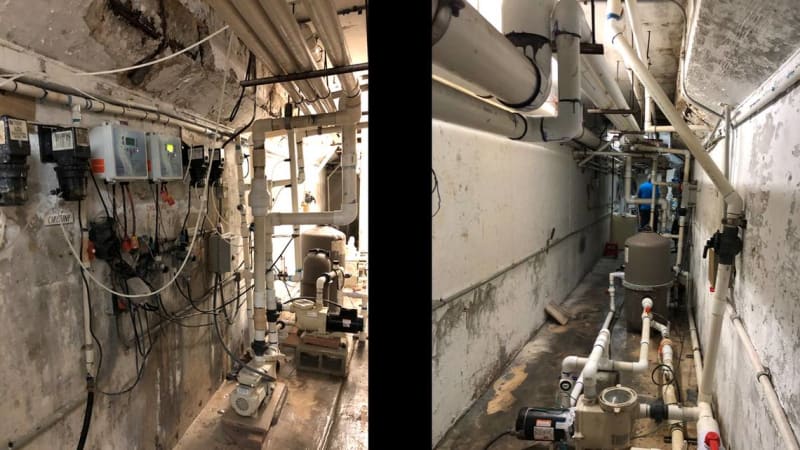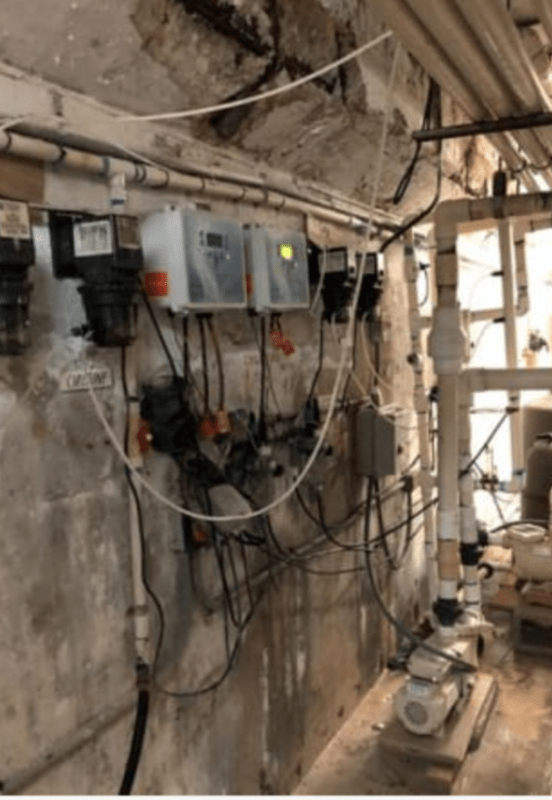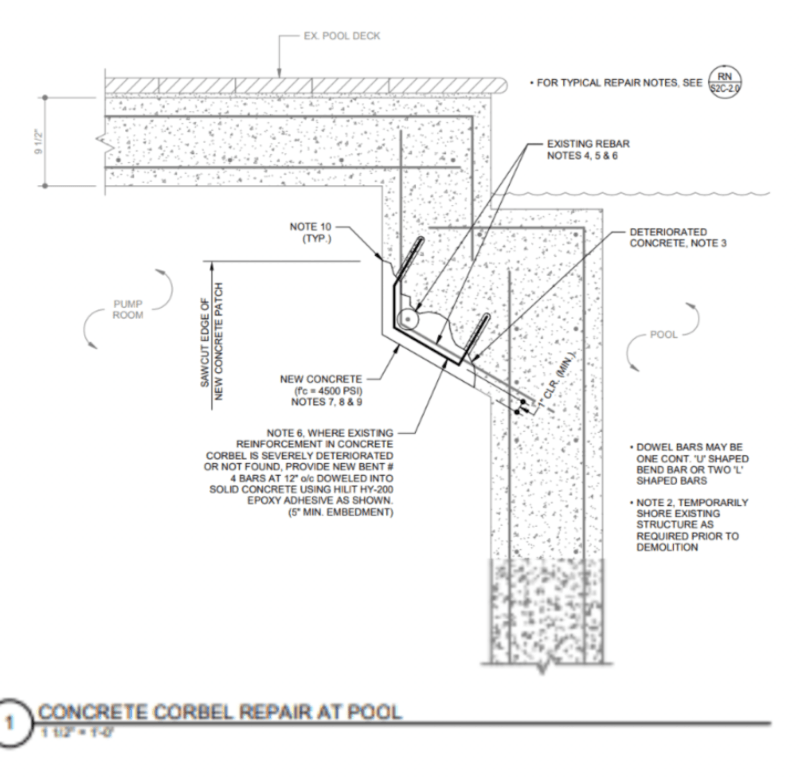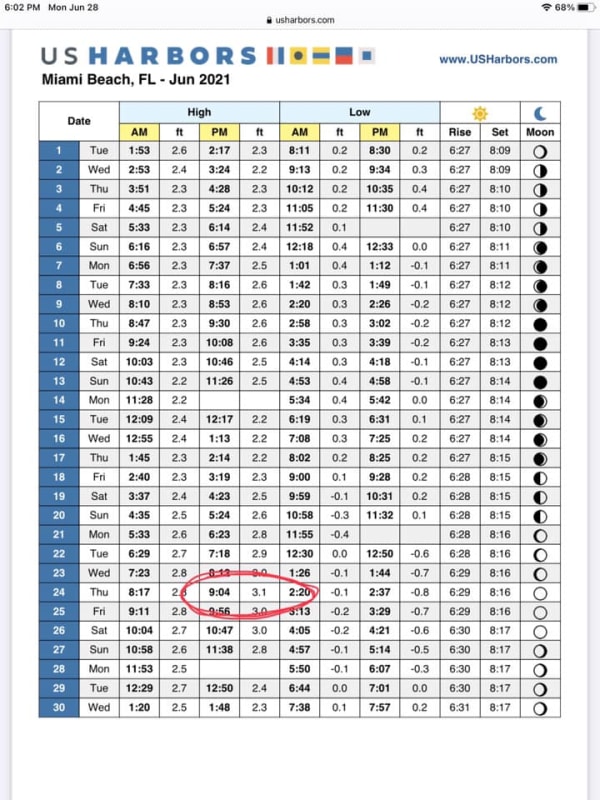Navigation
Install the app
How to install the app on iOS
Follow along with the video below to see how to install our site as a web app on your home screen.
Note: This feature may not be available in some browsers.
More options
Style variation
-
Congratulations TugboatEng on being selected by the Eng-Tips community for having the most helpful posts in the forums last week. Way to Go!
You are using an out of date browser. It may not display this or other websites correctly.
You should upgrade or use an alternative browser.
You should upgrade or use an alternative browser.
Miami Beach, Champlain Towers South apartment building collapse, Part 02 151
- Thread starter dik
- Start date
- Status
- Not open for further replies.
From the building drawings, the pool equipment area is to the south of the pool (left, in the picture above). Implied in the drawing is that you gain access to that area by moving through a "hallway" that is east of the pool--from the parking area. That does seem odd.
spsalso
spsalso
as per the interview referenced above by SFcharlie, spalling of concrete in the basement garage was in response to corrosion and swelling of the rebar due to salt water intrusion. The maintenance mgr claims that during his tenure (1995-2000) the garage would routinely flood to 2 ft depth of saltwater, and the salt water would seep thru cracks , and also enter normal portland cement based concrete due to its inherent porosity.
Florida has had other issues with salt water corrosion of rebar- many aged Florida bridges have similar issues with rebar corrosion , and I recall there was a FDOT project to address this by applying a coating of geopolymer cement over the concrete to impede the salt water ingresss- the geoplymer concrete GPC has over 1000 times lower porosity to salt water than does portland cement based concrete. Perhaps the same concept can be applied to underground and ground level concrete structures along the coast.
"...when logic, and proportion, have fallen, sloppy dead..." Grace Slick
Florida has had other issues with salt water corrosion of rebar- many aged Florida bridges have similar issues with rebar corrosion , and I recall there was a FDOT project to address this by applying a coating of geopolymer cement over the concrete to impede the salt water ingresss- the geoplymer concrete GPC has over 1000 times lower porosity to salt water than does portland cement based concrete. Perhaps the same concept can be applied to underground and ground level concrete structures along the coast.
"...when logic, and proportion, have fallen, sloppy dead..." Grace Slick
New photos from the pool equipment room. Condition was bad. But again, the pool above didn't collapse.

Pool equipment room picture 36 hrs before collapse. Contractor doing the pool equipment quote “There was standing water all over the parking garage”
“He thought it was waterproofing issues,” the contractor said of the staff member. “I thought to myself, that’s not normal.” He said Jose told him they pumped the pool equipment room so frequently that the building had to replace pump motors every two years.
The deepest puddle of standing water, according to the contractor, was located around parking spot 78 — an area that building plans show is located directly under the pool deck[...]"
spinspecdrt
Materials
This exact area was detailed in the R&R plans.




No, but the pool would be sitting on the ground so it wouldn't be putting any weight on the columns, and the deck around the pool wouldn't put to much load on the supports below. Also, that looks like a salt water system that's clearly been leaking. So even when the tide wasn't inundating the garage, the support columns were probably under a steady salt assault from the leaking pool fixtures.
- Thread starter
- #29
Some useful information on the NTSB's investigatory roll. . These investigations take time.
'Significantly Worse'
In a April 9 2021 letter Wodnicki [president of the Champlain Towers Association] noted that “indeed the observable damage such as in the garage has gotten significantly worse” since the first [2018] inspection.
In a April 9 2021 letter Wodnicki [president of the Champlain Towers Association] noted that “indeed the observable damage such as in the garage has gotten significantly worse” since the first [2018] inspection.
A concrete guy can correct me, but I have the impression that doing durable concrete foundations and structures in and near salt water can be done.
I have the impression that this building was not built with such techniques; it seems there was an assumption that salt and salt water was kept somewhere 20 miles away. And it was built accordingly.
spsalso
I have the impression that this building was not built with such techniques; it seems there was an assumption that salt and salt water was kept somewhere 20 miles away. And it was built accordingly.
spsalso
-
1
- #33
My only experience is in bridges. In a tidal zone (which the basement apparently was, considering reports of sea water flooding it during high tides), this would attract the most severe exposure classification (C2 in Australia). This would call for a minimum 50 MPa concrete with 65 mm of cover (as a building). A bridge would need >= 55 MPa concrete with 80 mm cover. Often stainless steel would be used.
What was used was 4000 psi (~28 MPa) with apparently the bare minimum cover, perhaps 1 inch. There was no hope that this was ever going to be a durable structure.
I doubt they would have known or expected that the basement would have seawater flowing in when it was designed.
What was used was 4000 psi (~28 MPa) with apparently the bare minimum cover, perhaps 1 inch. There was no hope that this was ever going to be a durable structure.
I doubt they would have known or expected that the basement would have seawater flowing in when it was designed.
-
1
- #34
Architect here - Thank you all for your knowledge.
The drawings show parking level at approximately elevation +2'
The high tide on the night of the collapse was at elevation +3.1" at 9:04 pm. Higher than usual
(note: times do not exactly concur)
Is it possible the hydro static pressure lifted the foundation causing added load on the ground level deck against the columns.
Leading to the ground level deck punching through the columns
If this happened then I can imagine transfer beams failed.
EDIT: just noticed low tide was an hour after collapse
Maybe the cyclical nature of the tides and hydrostatic pressure
It could make sense at the pool area as there is not the weight of a building over it

The drawings show parking level at approximately elevation +2'
The high tide on the night of the collapse was at elevation +3.1" at 9:04 pm. Higher than usual
(note: times do not exactly concur)
Is it possible the hydro static pressure lifted the foundation causing added load on the ground level deck against the columns.
Leading to the ground level deck punching through the columns
If this happened then I can imagine transfer beams failed.
EDIT: just noticed low tide was an hour after collapse
Maybe the cyclical nature of the tides and hydrostatic pressure
It could make sense at the pool area as there is not the weight of a building over it

-
2
- #36
"the columns were not designed for Penthouse loads: (various posters)
That may be true, but on its own, should not cause a gravity load failure unless the structure was severely under-designed from the get go.
It is likely that this building only had 20% or less of the design floor live in effect at any time. That a lot of unused demand over 12 stories.
That may be true, but on its own, should not cause a gravity load failure unless the structure was severely under-designed from the get go.
It is likely that this building only had 20% or less of the design floor live in effect at any time. That a lot of unused demand over 12 stories.
-
1
- #37
Here's a video that I haven't seen posted yet it's got some good speculation and pictures.
[URL unfurl="true"]https://youtu.be/dSQq2FimiXY[/url]
[URL unfurl="true"]https://youtu.be/dSQq2FimiXY[/url]
The building was oceanfront, less than 100 yards from the ocean. I don't believe there's a place in Miami that's 20 miles away from the ocean!spsalso said:I have the impression that this building was not built with such techniques; it seems there was an assumption that salt and salt water was kept somewhere 20 miles away. And it was built accordingly.
Based on ACI318-89, minimum concrete strength was 4750psi and w/c of .4.
Based on the current ACI318, it is exposure class C2 and is limited to minimum 35MPa (5000psi) concrete and w/c of .4 and 20 cover for slab bars and 40 cover for everything else!
So it has not changed a lot. Most of the concrete strengths used in the building should never been accepted.
Based on the current ACI318, it is exposure class C2 and is limited to minimum 35MPa (5000psi) concrete and w/c of .4 and 20 cover for slab bars and 40 cover for everything else!
So it has not changed a lot. Most of the concrete strengths used in the building should never been accepted.
- Thread starter
- #40
It would appear that way... even the repair did not appear to have taken into account the corrosive nature of salt spray... have to wait for more information.
Rather than think climate change and the corona virus as science, think of it as the wrath of God. Feel any better?
-Dik
- Status
- Not open for further replies.
Similar threads
- Replies
- 4
- Views
- 22K
- Locked
- Question
- Replies
- 120
- Views
- 15K
- Replies
- 4
- Views
- 755
- Locked
- Question
- Replies
- 1
- Views
- 2K
- Locked
- Question
- Replies
- 4
- Views
- 5K
